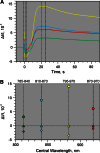Deconvolution of ferredoxin, plastocyanin, and P700 transmittance changes in intact leaves with a new type of kinetic LED array spectrophotometer
- PMID: 26837213
- PMCID: PMC4826414
- DOI: 10.1007/s11120-016-0219-0
Deconvolution of ferredoxin, plastocyanin, and P700 transmittance changes in intact leaves with a new type of kinetic LED array spectrophotometer
Abstract
A newly developed compact measuring system for assessment of transmittance changes in the near-infrared spectral region is described; it allows deconvolution of redox changes due to ferredoxin (Fd), P700, and plastocyanin (PC) in intact leaves. In addition, it can also simultaneously measure chlorophyll fluorescence. The major opto-electronic components as well as the principles of data acquisition and signal deconvolution are outlined. Four original pulse-modulated dual-wavelength difference signals are measured (785-840 nm, 810-870 nm, 870-970 nm, and 795-970 nm). Deconvolution is based on specific spectral information presented graphically in the form of 'Differential Model Plots' (DMP) of Fd, P700, and PC that are derived empirically from selective changes of these three components under appropriately chosen physiological conditions. Whereas information on maximal changes of Fd is obtained upon illumination after dark-acclimation, maximal changes of P700 and PC can be readily induced by saturating light pulses in the presence of far-red light. Using the information of DMP and maximal changes, the new measuring system enables on-line deconvolution of Fd, P700, and PC. The performance of the new device is demonstrated by some examples of practical applications, including fast measurements of flash relaxation kinetics and of the Fd, P700, and PC changes paralleling the polyphasic fluorescence rise upon application of a 300-ms pulse of saturating light.
Keywords: Chlorophyll fluorescence; Cyclic electron transport; FeS proteins; Flash relaxation kinetics; Photosystem I; Polyphasic fluorescence rise; Thioredoxin.
Figures












Similar articles
-
Redox changes of ferredoxin, P700, and plastocyanin measured simultaneously in intact leaves.Photosynth Res. 2017 Dec;134(3):343-360. doi: 10.1007/s11120-017-0394-7. Epub 2017 May 11. Photosynth Res. 2017. PMID: 28497192 Free PMC article.
-
Analysis of Photosystem I Donor and Acceptor Sides with a New Type of Online-Deconvoluting Kinetic LED-Array Spectrophotometer.Plant Cell Physiol. 2016 Jul;57(7):1454-1467. doi: 10.1093/pcp/pcw044. Epub 2016 Apr 5. Plant Cell Physiol. 2016. PMID: 27053032
-
Near-infrared in vitro measurements of photosystem I cofactors and electron-transfer partners with a recently developed spectrophotometer.Photosynth Res. 2019 Dec;142(3):307-319. doi: 10.1007/s11120-019-00665-2. Epub 2019 Sep 3. Photosynth Res. 2019. PMID: 31482263
-
Cyclic electron flow in C3 plants.Biochim Biophys Acta. 2006 May-Jun;1757(5-6):362-8. doi: 10.1016/j.bbabio.2006.02.018. Epub 2006 May 15. Biochim Biophys Acta. 2006. PMID: 16762315 Review.
-
Prying into the green black-box.Photosynth Res. 2022 Nov;154(2):89-112. doi: 10.1007/s11120-022-00960-5. Epub 2022 Sep 16. Photosynth Res. 2022. PMID: 36114436 Review.
Cited by
-
Photosystem I Inhibition, Protection and Signalling: Knowns and Unknowns.Front Plant Sci. 2021 Dec 1;12:791124. doi: 10.3389/fpls.2021.791124. eCollection 2021. Front Plant Sci. 2021. PMID: 34925429 Free PMC article. Review.
-
A theoretical framework of the hybrid mechanism of photosystem II photodamage.Photosynth Res. 2021 Aug;149(1-2):107-120. doi: 10.1007/s11120-021-00843-1. Epub 2021 Aug 2. Photosynth Res. 2021. PMID: 34338941
-
Lighting the light reactions of photosynthesis by means of redox-responsive genetically encoded biosensors for photosynthetic intermediates.Photochem Photobiol Sci. 2023 Aug;22(8):2005-2018. doi: 10.1007/s43630-023-00425-1. Epub 2023 May 17. Photochem Photobiol Sci. 2023. PMID: 37195389 Review.
-
Machine learning methods for assessing photosynthetic activity: environmental monitoring applications.Biophys Rev. 2022 Aug 10;14(4):821-842. doi: 10.1007/s12551-022-00982-2. eCollection 2022 Aug. Biophys Rev. 2022. PMID: 36124273 Free PMC article. Review.
-
The photosystem I supercomplex from a primordial green alga Ostreococcus tauri harbors three light-harvesting complex trimers.Elife. 2023 Mar 23;12:e84488. doi: 10.7554/eLife.84488. Elife. 2023. PMID: 36951548 Free PMC article.
References
-
- Aronsson H, Schöttler M, Kelly AA, Sundquist C, Dörmanns P, Karim S, Jarvis P. Monogalactosyldiacylglycerol deficiency in Arabidopsis affects pigment composition in the prolamellar body and impairs thylakoid membrane energization and photoprotection in leaves. Plant Physiol. 2008;148:580–592. doi: 10.1104/pp.108.123372. - DOI - PMC - PubMed
MeSH terms
Substances
LinkOut - more resources
Full Text Sources
Other Literature Sources
Miscellaneous

